 |
 |
 |
| |
DUET-1 and DUET-2: TMC125 versus placebo in treatment-experienced HIV-1-infected patients
|
| |
| |
Reported by Jules Levin
4th IAS Conference on HIV Pathogenesis, Treatment, and Prevention
July 22-25, 2007
Sydney, Australia
In DUET 1 and 2, highly treatment experienced patients received TMC125 (or placebo) plus TMC114 along with optimized NRTIs. Viral load reduction and percent <50 and <400 copies/ml were statistically superior for patients receiving TMC125 compared to placebo. A unique list of 13 NNRTI mutation are reported by the study investigators that are associated with reduced response to TMC125. Of note, K103N is not on the list, of note it took 3 of these mutations to impact response to TMC125, and also noteworthy they reported only 14% of patients in the study had 3 or more TMC125 mutations. Investigators also reported that Y181C, a common NNRTI mutation, did not compromise response to TMC125 unless 2 or more additional TMC125 mutations are also present. The overall incidence of rash was 17% for TMC125 vs 9% for placebo, mostly mild to moderate and self-limiting, no association with CD4 count, no gender difference although higher incidence in women, no mucosal involvement, and no apparent increased risk in patients with a history of NNRTI-related rash. The incidence of treatment-emergent lipid and liver abnormalities appears not an issue.
The very last presentation at the IAS meeting was this one and of course it was of great interest. Overall the meeting was well organized and an enjoyable meeting; there was a good amount of important information here including that using ‘meth' reduces CD4 counts, that treating kids early appears helpful, prevents death, in Africa study (like in adults); Maraviroc looks good, TMC114+TMC125 looks good (DUET Studies); Merck reported 48 weeks data on Raltegravir in naives and it looks as expected: neutral lipids effects and potent and tolerable. TMC278 looks relatively lipid neutral with less side effects than efavirenz. Perhaps the biggest story from the meeting is the GSK abacavir study of the first genetic test in HIV: a genetic blood test for abacavir hypersensitivity is close to 100% in predicting whether or not a patient will develop abacavir associated hypersensitivity. This means you can have this blood test done by a doctor and know with close to 100% assurity whether you can use abacavir without expectation of experiencing hypersensitivity. Two new CCR5 drugs in addition to Maraviroc are being developed: Schering's Vicriviroc and Incyte's new drug. It appears that the NIH is moving ahead with a pilot study of a "When To Begin HAART" Study.
Christine Katlama did a nice job of jointly reporting the results from DUET 1 and 2 at the very last session of the conference. I'm in my room filing my last reports from Sydney and catching a 1pm flight back to NYC, a 18 hour flight and 5-hour layover in LA!!!
DUET-1: Anthony Mills, Pedro Cahn, Beatriz Grinsztejn, Richard Haubrich,
Jacob Lalezari, José Valdez Madruga, Gilles Pialoux, Timothy Wilkin,
Monika Peeters, Johan Vingerhoets, Goedele De Smedt, Lorant Leopold,
Roberta Trefiglio and Brian Woodfall
DUET-2: Christine Katlama, Thomas Campbell, Bonaventura Clotet,
Margaret Johnson, Adriano Lazzarin, Keikawus Arastéh, William Towner, Benoit Trottier, Monika Peeters, Johan Vingerhoets, Goedele De Smedt,
Benny Baeten, Greet Beets, Rekha Sinha and Brian Woodfall
DUET-1: Thailand, France, North and South America. Madruga JV, et al. Lancet 2007:370;29-38
DUET-2: Australia, Europe, North America. Lazzarin A, et al. Lancet 2007:370;39-48
AUTHOR CONCLUSIONS
In treatment-experienced patients, including those with NNRTI resistant virus, TMC125 consistently demonstrated superiority over placebo
-- 56% (DUET-1) and 62% (DUET-2) of patients achieved confirmed undetectable VL (<50 copies/mL) with TMC125 plus BR at Week 24
Even in the absence of any other fully active background agents, with TMC125, over 40% of patients achieved undetectable (<50 copies/mL)
viral load
-- response rates increased as more active agents were used in the background regimen
Thirteen TMC125 resistance-associated mutations (TMC125 RAMs) were identified
-- in the presence of 0, 1 and 2 TMC125 RAMs, virological responses were greater than the overall placebo response
-- only 14% of all patients had ≥3 TMC125 RAMs
Except for rash, incidence and severity of AEs with TMC125 were similar to placebo
TMC125 has the ability to extend and enhance the NNRTI class and provide a new treatment option for patients with resistance to and/or unable to tolerate other NNRTI's
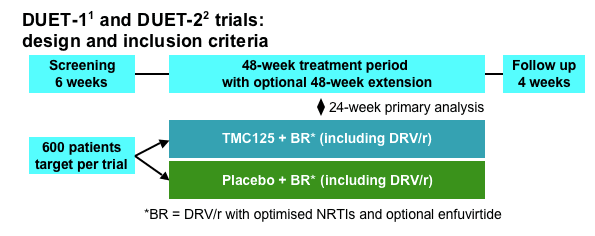
Viral load >5,000 HIV-1 RNA copies/mL and stable therapy for ≥8 weeks
≥1 NNRTI RAM, at screening or in documented historical genotype
≥3 primary PI mutations at screening
Primary endpoint was the proportion of patients achieving viral load
<50 HIV-1 RNA copies/mL when all patients had reached Week 24 or discontinued
1. Madruga, et al. Lancet 2007;370:29-38
2. Lazzarin, et al. Lancet 2007;370:39-48
Published in The Lancet just before IAS meeting.
DUET-1 and DUET 2:
baseline characteristics and background ARVs
Study patients were highly treatment-experienced: 65% had prior ART use of 10-15 HIV drugs; 65% had 2 or more detectable NNRTI mutations (RAMs); 60% had 4 or more primary PI mutations (RAMs); 40% used Fuzeon in background regimen but 25% used Fuzeon for the first time (de novo). 15% of patients had PSS score=0 and 31% had PSS=1.
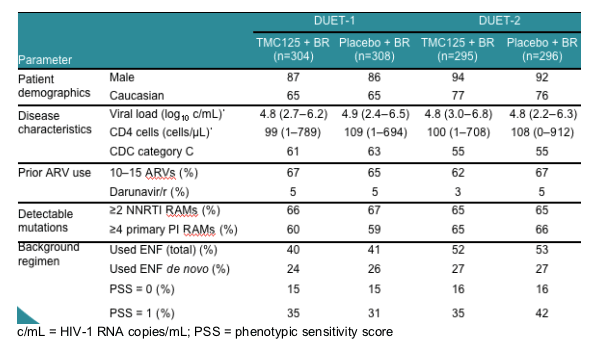
DUET-1 and DUET-2 primary endpoint: patients with viral load <50 copies/mL at Week 24 TLOVR
In DUET-1, 56% taking TMC125 vs 39% not taking TMC125 achieved <50 c/ml (p=0050). In DUET 2, 62% of patients taking TMC125 vs 44% not taking TMC125 achieved <50 c/ml (p=0.0003).
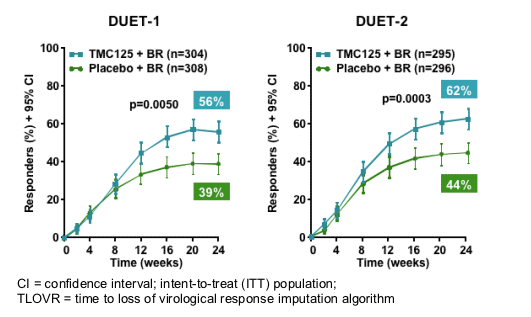
DUET-1 and -2: patients with HIV-RNA <400 copies/mL to week 24
IN DUET-1, 74% of patients taking TMC125 compared to 51% who received placebo achieved <400 c/ml (p=0.0001). In DUET-2, 75% of patientstaking TMC125 vs 54% not taking TMC125 (placebo) achieved <400 c/ml (p=0.0001).
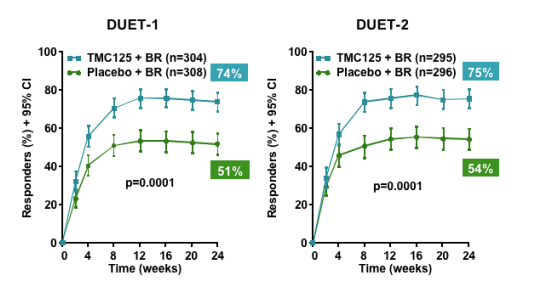
DUET-1 and DUET-2:
viral load reduction from baseline to week 24
Viral load reductions from baseline to week 24 for patients taking TMC125 were -2.4 & -2.3 logs in DUET 1 & 2 compared to -1.7 for the patients taking placebo in both studies (p<0.0001).
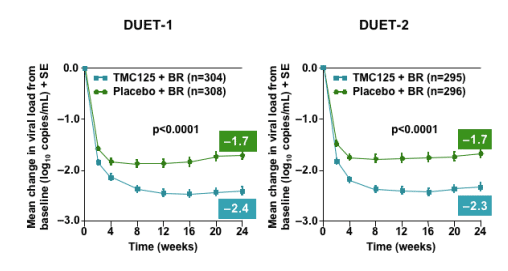
DUET-1 and DUET-2:
change in CD4 cell count from baseline
CD4 increases were better in the TMC125 arms: +89 from baseline compared to +64 in the placebo arm in DUET-1 (p=0.0002). In DUET-2 the CD$ increase was +78 for patients taking TMC125 vs +66 for patients taking placebo, but this was not statistically significant (p=0.3692).
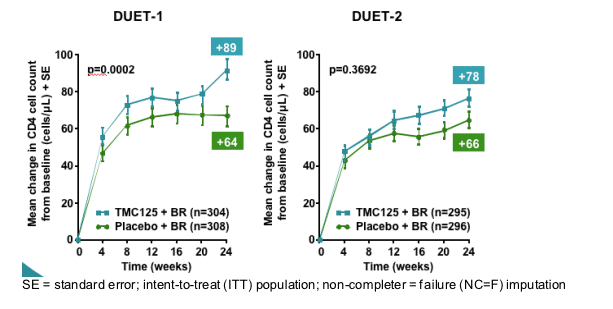
DUET-1 and DUET-2: response (VL <50 copies/mL)
according to number of active background ARVs
Darunavir and enfuvirtide are counted as active if FC<10 or used de novo, respectively;
PSS = phenotypic sensitivity score
Taking TMC125 was most helpful to patients when they had few treatment options. For patients with PSS=0 47% in DUET-1 and 44% in DUET-2 achieved <50 when taking TMC125 compared to 0% and 7% in DUET 1 & 2 who received placebo. When PSS=0, 1, or 2 taking TMC125 provided the most benefit. When patients had PSS=3 or more in DUET-2 achieving <50 when taking TMC125 was 80% vs 73% if not taking TMC125. And in DUET-1 if patients had PSS=3 or more (sensitive to 3 or more drugs), the % <50 was the same whether or not taking TMC125.
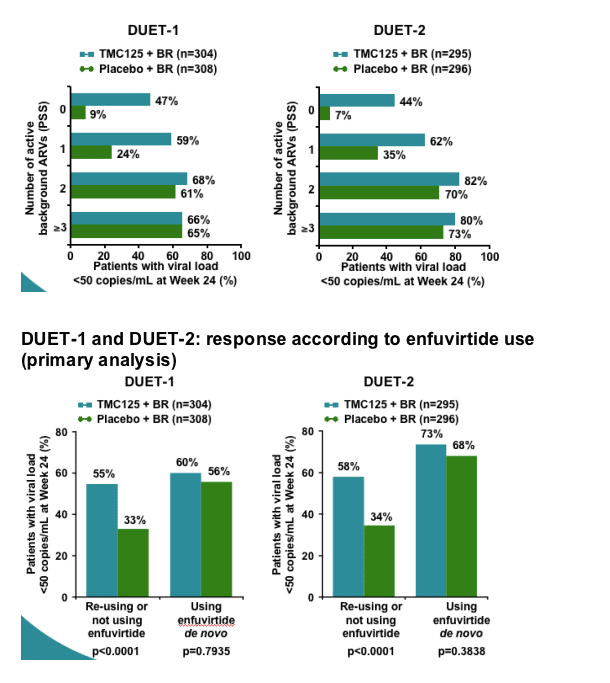
DUET-1 and DUET-2: virological response
(<50 copies/mL) according to baseline mutations
--13 baseline Resistance-Associated Mutations were associated with a decreased response to TMC125
(TMC125 RAMs): (Note that K103N is not on this list)
V90I A98G
L100I K101E/P
V106I V179D/F
Y181C/I/V G190A/S
--When 3 of these TMC125 RAMs were present the response rate was comparable to the overall placebo response*
†analysis performed in n=406 (100%); *overall placebo response = 36%
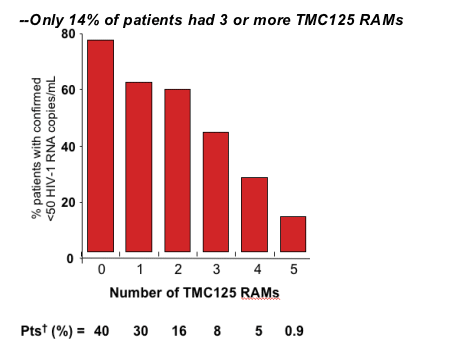
What is the effect of Y181C on TMC125 response rates?
Y181C is a common mutation conferring resistance to currently available NNRTIs
The TMC125 response rate is not compromised when Y181C is present, with either 0 or 1 other TMC125 RAM
When Y181C is present with two or more TMC125 RAMs (13% of all patients), response rates were substantially reduced
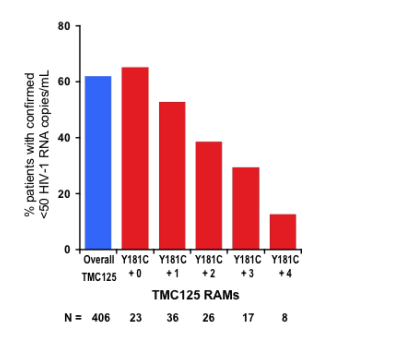
DUET-1 and DUET-2:
overview of adverse events (AEs)
The adverse events profile for TMC125 appears fairly comparable to placebo except for rash: in DUET-1, 20% taking TMC125 vs 10% taking placebo experienced rash of any type, and in DUET-2 14% taking TMC125 had rash of any type vs 9% for placebo. But this might be expected considering TMC125 is a NNRTI. Any AE (any cause) was comparable across all arms in study. Grade 3-4 AEs were comparable across study arms (21-28%). Serious AEs were a bit lower in TMC125 arms: 12-15% vs 17-20% for placebo. Deaths were lower in TMC125 arms: 1.3% for TMC125 vs 2.5% for placebo. Nausea was 14% for TMC125 vs 10-12% for placebo. Diarrhea was 12-18% for TMC125 vs 20% for placebo. Headache was 10% for TMC125 vs 12% for placebo. Injection site reaction was the same whether a patient took TMC125 or placebo. Nervous system disorders were 15% for patients taking TMC125 vs 17-20% for patients taking placebo. Psychiatric disorders for patients taking TMC125 were 10% in DUET-1 and 16% in DUET-2 vs 14% and 17% for patients taking placebo in DUET 1 & 2. Hepatic AEs were similar across all arms: 5% for TMC125 vs 4% and 7% for placebo in DUET 1 & 2.
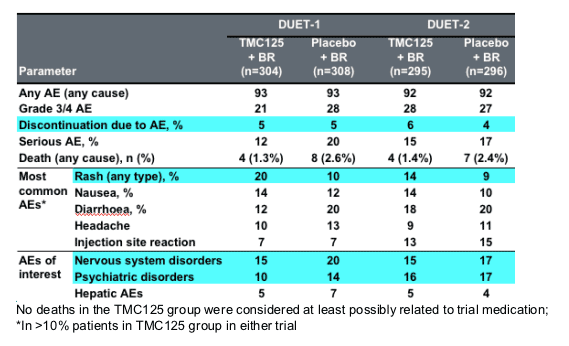
Summary of Rash: DUET 1 and 2
Overall incidence
--17% in TMC125 group vs 9% in placebo group
Onset: most frequent in 2nd week of therapy
Severity
--usually mild to moderate; 1% grade 3 and 0% grade 4
--no rashes with mucosal involvement
Infrequently lead to discontinuation (2%)
--most self-limiting with continued treatment
Higher incidence in women, but no gender difference in severity or treatment discontinuations
No association between rash and baseline CD4 cell count
In patients with a history of NNRTI-related rash, there was no apparent increased risk.
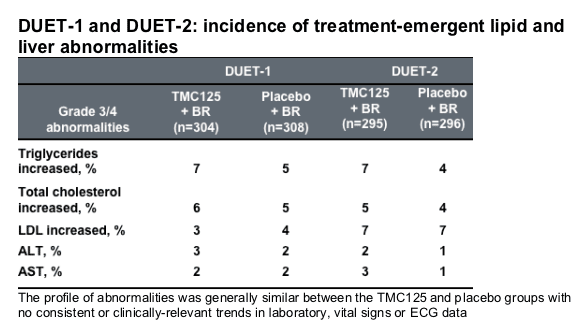
|
| |
|
 |
 |
|
|